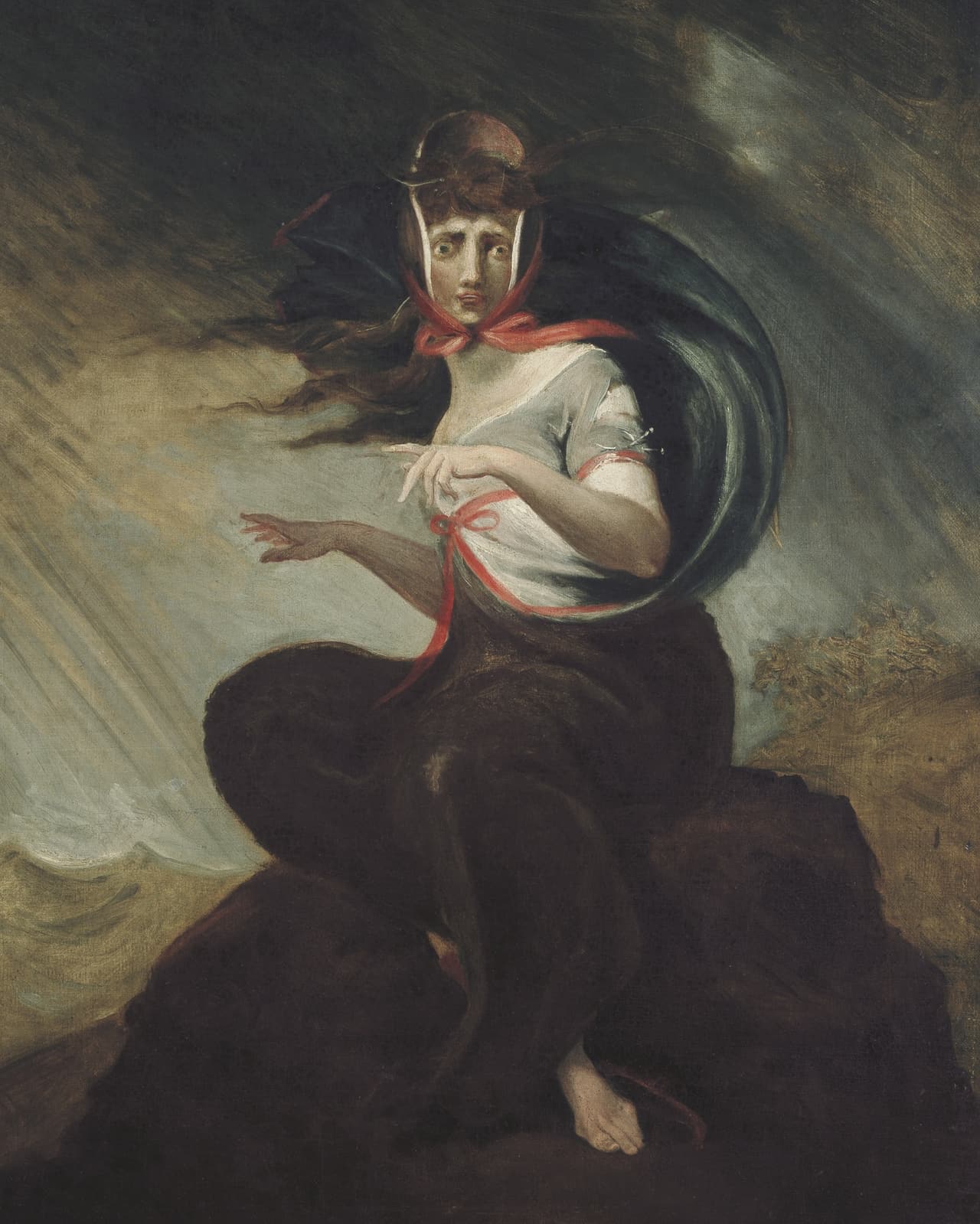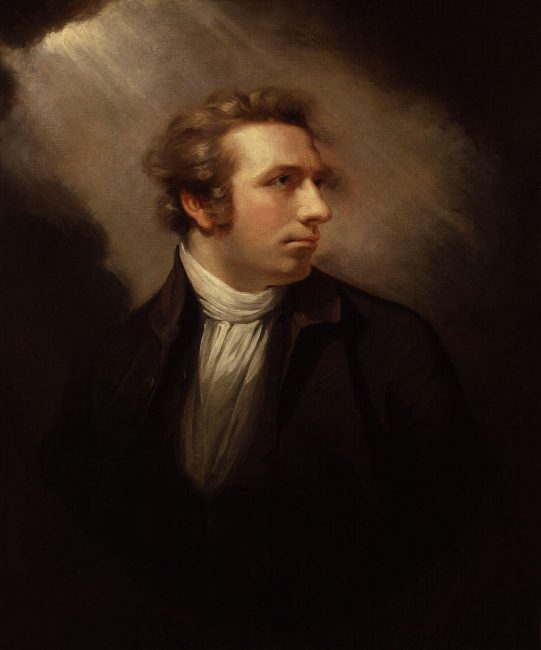
Claroscuro Johann Heinrich Füssli
Artwork Details Overview Catalogue Entry Provenance Exhibition History References Notes Title: The Night-Hag Visiting Lapland Witches Artist: Henry Fuseli (Swiss, Zürich 1741-1825 London) Date: 1796 Medium: Oil on canvas Dimensions: 40 x 49 3/4 in. (101.6 x 126.4 cm) Classification: Paintings

Chez Sentinelle Johann Heinrich Füssli (peinture)
Fuseli, Henry (Johann Heinrich Füssli) (1741-1825). Swiss-born painter, draughtsman, and writer on art, active mainly in England, where he was one of the outstanding figures of the Romantic movement.. He was the son of a portrait painter, Johann Caspar Füssli (1707-82), but he originally trained as a priest; he took holy orders in 1761, but never practised.

Il Caffé dell'Arte Johann Heinrich Füssli La Follia Di Kate 18061807
Johann Heinrich Füssli RA (* 7. Februar 1741 in Zürich; † 16. April 1825 in Putney bei London) war ein schweizerisch-englischer Maler und Publizist, der in England als Henry Fuseli bekannt wurde. Inhaltsverzeichnis 1 Leben 2 Werk 2.1 Der Maler 2.2 Der Schriftsteller 2.3 Der Herausgeber 3 Literatur 4 Filme 5 Weblinks 6 Einzelnachweise Leben
The Inquisition by Henry Fuseli (Johann Heinrich Füssli) (17411825, Switzerland
When the artist Henry Fuseli (Johann Heinrich Füssli) died in 1825, he left behind in London's Somerset House an intriguing set of drawings. Though he had a somewhat respectable role in the art establishment and received the honour of burial in St Paul's Cathedral, these drawings represent a more private side to the artist's practice.

Johann Heinrich Fussli Henry Fuseli The Vision Of Orestes Widewalls
Working during the height of the Enlightenment, the so-called "Age of Reason," the Swiss-English painter Henry Fuseli (born Johann Heinrich Füssli) instead chose to depict darker, irrational forces in his famous painting The Nightmare.. In Fuseli's startling composition, a woman bathed in white light stretches across a bed, her arms, neck, and head hanging off the end of the mattress.

Johann Heinrich Füssli, il pittore del diavolo altmarius
Henry Fuseli RA (German: Johann Heinrich Füssli; 7 February 1741 - 17 April 1825) was a Swiss painter, draughtsman and writer on art who spent much of his life in Britain. Many of his works, such as The Nightmare, deal with supernatural subject-matter. He painted works for John Boydell's Shakespeare Gallery, and created his own "Milton Gallery".

Ausstellung in Basel Johann Heinrich Füssli im Kunstmuseum Drama, Baby! Kultur SRF
Johann Heinrich Fussli (Henry Fuseli) Two Figures, One Holding a Tablet or Book Unknown Royal Scottish Academy of Art. Johann Heinrich Füssli [ˈjoːhan ˈhaɪ̯nʁɪç ˈfyːsli]; 7 February 1741 - 17 April 1825) was a Swiss painter, draughtsman, and writer on art who spent much of his life in Britain. Many of his works depict.

Füssli, La vision de Saint Jean JeanFrançois Heim
Johann Heinrich Füssli (known as Henry Fuseli) was born in Zürich on February 7th, 1741. He was the second of 18 children born to the Swiss portrait painter, Johann Caspar Füssli and his wife, Anna Elisabeth Waser. Caspar was a collector of sixteenth and seventeenth century Swiss art and passed his appreciation of fine art onto his son.

Johann Heinrich Füssli, il pittore del diavolo altmarius
Henry Fuseli (Johann Heinrich Füssli) was an Anglo-Swiss painter (1741-1825) who was more well known in his lifetime for his art history lectures and writing rather than his artwork. However, The Nightmare by Henry Fuseli would gain notoriety in the art world after its exhibition in the Royal Academy in the summer of 1782.

Johann Heinrich Füssli (o Fuseli). La pesadilla (o El Íncubo) nightmere Historia del arte
Henry Fuseli, (born February 7, 1741, Zürich, Switzerland—died April 16, 1825, Putney Hill, London, England), Swiss-born artist whose paintings are among the most dramatic, original, and sensual works of his time. Fuseli was reared in an intellectual and artistic milieu and initially studied theology.

Johann Heinrich Füssli (17411825)circle, Nick Bo
The Nightmare is a 1781 oil painting by Swiss artist Henry Fuseli. It shows a woman in deep sleep with her arms thrown below her, and with a demonic and ape-like incubus crouched on her chest. The painting's dreamlike and haunting erotic evocation of infatuation and obsession was a huge popular success.

Füssli. Mode Fetisch Fantasie KUNSTHAUS
Fuseli greatly admired John Milton's poetry. Here, he was inspired by a short passage of Paradise Lost, where Milton alludes to glimpsing or dreaming of the midnight revels of fairies. A spiral of ethereal fairies swirl in the sky as a shepherd sleeps below. Fuseli hoped to capture the viewer's imagination with his magical subject.

Kunst Wie Johann Heinrich Füssli zum Meister des nächtlichen Schreckens wurde SÜDKURIER
Henry Fuseli ( FEW-zə-lee, few-ZEL-ee; German: Johann Heinrich Füssli [ˈjoːhan ˈhaɪ̯nʁɪç ˈfyːsli]; 7 February 1741 - 17 April 1825) was a Swiss painter, draughtsman, and writer on art who spent much of his life in Britain. Many of his works depict supernatural experiences, such as The Nightmare.

Johann Heinrich Füssli and the Rise of Romanticism SciHi Blog
Henry Fuseli's original name was Johann Heinrich Füssli, and he was born in 1741 on February 7 in Zürich, Switzerland. He died in April 1825. Fuseli was exposed to art from an early age because his father, Johann Caspar Füssli, was an artist and writer.

Lot Johann Heinrich Füssli (17411825)circle, Nick Bo
Henry Fuseli RA ( / ˈfjuːzəli, fjuːˈzɛli / FEW-zə-lee, few-ZEL-ee; [1] [2] [3] German: Johann Heinrich Füssli [ˈjoːhan ˈhaɪ̯nʁɪç ˈfyːsli]; 7 February 1741 - 17 April 1825) was a Swiss painter, draughtsman, and writer on art who spent much of his life in Britain. Many of his works depict supernatural experiences, such as The Nightmare.

Oil Painting Replica Silence, 1799 by Henry Fuseli (Johann Heinrich Füssli) (17411825
See all 39 artworks ›. Milton Dictating to His Daughter, 1794. Henry Fuseli. Two Heads of Damned Souls from Dante's "Inferno" (front and back), 1770/78. Henry Fuseli. Sketch for "Oath on the Rütli," Female Figure (verso), 1779/81; 1785/90 (verso) Henry Fuseli. Ugolino and His Sons Starving to Death in the Tower, 1806.
